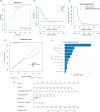Integrating 7-day D-dimer exposure into deep vein thrombosis risk prediction after gastrointestinal surgery
- PMID: 40804452
- PMCID: PMC12350792
- DOI: 10.1038/s41598-025-14960-7
Integrating 7-day D-dimer exposure into deep vein thrombosis risk prediction after gastrointestinal surgery
Abstract
Deep vein thrombosis (DVT) is a serious complication following gastrointestinal surgery. While D-dimer is a widely used biomarker for thrombosis, its postoperative specificity is limited due to inflammatory interference. This study introduces a novel cumulative metric-7-day D-dimer exposure (7dDDE)-to quantify perioperative coagulation burden. We retrospectively analyzed 525 patients undergoing gastrointestinal surgery, performed propensity score matching, and constructed a multivariable logistic regression model incorporating 7dDDE and other clinical variables. Model performance was evaluated using ROC curves, decision curve analysis, calibration plots, SHAP values, and a nomogram. Additionally, a linear mixed-effects model assessed D-dimer trajectories over time. The results demonstrated that 7dDDE was independently associated with postoperative DVT and was the most influential predictor in the model. The model showed good discrimination and clinical utility. Longitudinal analysis further revealed significant differences in D-dimer dynamics between DVT and non-DVT groups, even after adjustment for confounders. These findings support the use of 7dDDE as a robust biomarker for thrombotic risk stratification and highlight the importance of integrating temporal biomarker patterns into perioperative DVT prediction.
© 2025. The Author(s).
Conflict of interest statement
Declarations. Competing interests: The authors declare no competing interests. Declaration of generative AI use: The authors declare that no generative artificial intelligence tools were used in the writing of this manuscript.
Figures



Similar articles
-
Building and Verifying a Prediction Model for Deep Vein Thrombosis Among Spinal Cord Injury Patients Undergoing Inpatient Rehabilitation.World Neurosurg. 2025 Feb;194:123451. doi: 10.1016/j.wneu.2024.11.034. Epub 2024 Dec 6. World Neurosurg. 2025. PMID: 39571896
-
Comparison of Two Modern Survival Prediction Tools, SORG-MLA and METSSS, in Patients With Symptomatic Long-bone Metastases Who Underwent Local Treatment With Surgery Followed by Radiotherapy and With Radiotherapy Alone.Clin Orthop Relat Res. 2024 Dec 1;482(12):2193-2208. doi: 10.1097/CORR.0000000000003185. Epub 2024 Jul 23. Clin Orthop Relat Res. 2024. PMID: 39051924
-
Are Current Survival Prediction Tools Useful When Treating Subsequent Skeletal-related Events From Bone Metastases?Clin Orthop Relat Res. 2024 Sep 1;482(9):1710-1721. doi: 10.1097/CORR.0000000000003030. Epub 2024 Mar 22. Clin Orthop Relat Res. 2024. PMID: 38517402
-
Home versus in-patient treatment for deep vein thrombosis.Cochrane Database Syst Rev. 2018 Jan 9;1(1):CD003076. doi: 10.1002/14651858.CD003076.pub3. Cochrane Database Syst Rev. 2018. PMID: 29315455 Free PMC article.
-
The measurement and monitoring of surgical adverse events.Health Technol Assess. 2001;5(22):1-194. doi: 10.3310/hta5220. Health Technol Assess. 2001. PMID: 11532239
References
-
- Weitz, J. I. & Chan, N. C. Novel antithrombotic strategies for treatment of venous thromboembolism. Blood135(5), 351–359. 10.1182/blood.2019000919 (2020). - PubMed
-
- Gordon, R. J. & Lombard, F. W. Perioperative venous thromboembolism: A review. Anesth. Analg.125(2), 403–412. 10.1213/ANE.0000000000002183 (2017). - PubMed
-
- Bartlett, M. A., Mauck, K. F., Stephenson, C. R., Ganesh, R. & Daniels, P. R. Perioperative venous thromboembolism prophylaxis. Mayo Clin. Proc.95(12), 2775–2798. 10.1016/j.mayocp.2020.06.015 (2020). - PubMed
-
- Heit, J. A. et al. The epidemiology of venous thromboembolism in the community. Thromb. Haemost.86(1), 452–463 (2001). - PubMed
Grants and funding
LinkOut - more resources
Full Text Sources

